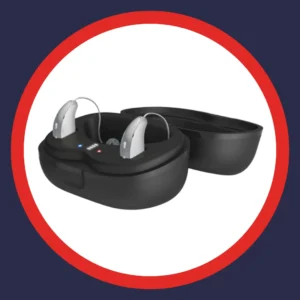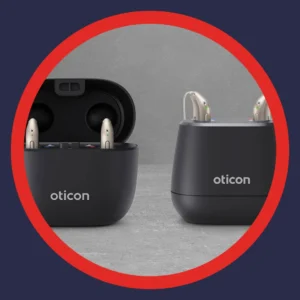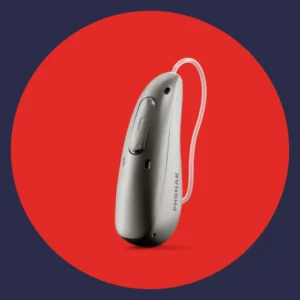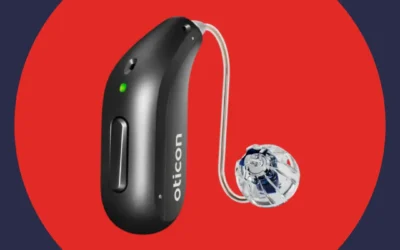Hearing aid technology is evolving faster than ever. What once simply made sounds louder now thinks, learns, and connects in ways that improve life every day. Today’s advanced hearing aids combine artificial intelligence, neural processing, and seamless Bluetooth connections to deliver a clearer, more natural listening experience.
These innovations are transforming what it means to hear well. Patients no longer have to choose between clarity and convenience. With help from trusted professionals at American Hearing + Audiology, users can experience smarter hearing solutions that adapt automatically to their surroundings and routines.
Modern hearing aids do more than amplify sound. They understand it.
1. Artificial Intelligence That Thinks Like You
Artificial intelligence now drives the most advanced hearing aid technology. Instead of using fixed programs, AI hearing aids constantly analyze the world around you and adjust automatically. They learn how you listen, recognize the places you visit most, and deliver crystal-clear sound wherever life takes you.
How AI Hearing Aids Work
AI hearing aids perform tasks once handled only by the brain. They:
- Analyze environments in real time. Sound sensors scan your surroundings hundreds of times per second.
- Learn your preferences. The system remembers your favorite volume and tone balance for each environment.
- Enhance voices automatically. Speech is lifted forward while background noise fades naturally.
- Adapt on their own. AI uses feedback from daily use to fine-tune clarity and comfort without manual adjustments.
- Reduce mental effort. With smarter sound separation, you hear speech clearly and stay focused longer.
These abilities help you stay connected and relaxed, even in crowded restaurants or outdoor events.

Example: Starkey Edge AI
The Starkey Edge AI hearing aid shows how far AI has advanced. Its Edge Mode+ feature activates with a simple tap, instantly sharpening voices in difficult listening conditions. The device studies the acoustic scene and applies targeted changes within seconds, providing effortless clarity in conversation.
AI Advantages at a Glance
|
Benefit |
What It Means for You |
|
Personalized sound |
Learns and adjusts to your hearing needs automatically |
|
Instant speech focus |
Detects and enhances voices in any environment |
|
Smart noise control |
Reduces background interference without distortion |
|
Comfort learning |
Remembers how you like to hear in each location |
|
Less listening fatigue |
Lets your brain rest while staying fully engaged |
AI hearing aids do not just react—they predict what you need next. They create sound that feels natural, balanced, and completely personal.
For more insight into how leading AI systems compare, see our guide on Phonak vs. Starkey hearing aids.
2. Neural Network Sound Processing: Hearing at the Speed of the Brain
Artificial intelligence made hearing aids smarter. Neural network processing makes them think like the human brain. This new level of hearing aid technology uses deep neural networks (DNNs)—systems trained on millions of real-world sounds—to understand speech, reduce background noise, and deliver sound that feels natural and effortless.
Instead of just amplifying everything, DNNs recognize patterns in the environment and decide how each sound should be treated. This allows for remarkably clear speech, even in the most complex soundscapes.
How Neural Network Processing Works
Modern DNN-powered hearing aids perform advanced sound analysis in real time. They:
- Recognize and classify sound scenes such as quiet rooms, cars, and busy cafés.
- Separate voices from background noise with near-human accuracy.
- Reconstruct sound naturally so speech feels organic, not artificial.
- Reduce listening effort by letting the hearing aid handle complex sound separation.
- Adapt instantly as environments shift, keeping you tuned into the right sounds.
This is sound processing modeled after the brain’s own pathways for understanding speech.
Flagship Models with Neural Precision
|
Model |
Technology Core |
Key Benefit |
Best For |
|
Phonak Audéo Sphere Infinio |
DEEPSONIC DNN Processor |
Separates speech from any direction in real time |
Busy, social environments |
|
ReSound Vivia |
Intelligence Augmented DNN |
Highlights speech while reducing surrounding noise |
Everyday listening comfort |
|
Starkey Edge AI |
Neuro Processor |
Applies fast AI-based adjustments to boost clarity |
Quick sound optimization needs |
Why Neural Processing Matters
Neural networks improve how the brain and hearing aid work together. By reducing distortion and enhancing speech cues, users experience:
- More natural sound quality
- Easier conversations in noisy settings
- Sharper focus with less fatigue
- Smoother transitions between environments
This kind of precision makes conversations effortless and music more enjoyable. It represents a leap beyond basic digital sound toward lifelike listening.
For a closer look at how these models stack up, explore ReSound Vivia vs. Starkey Edge AI.
3. Bluetooth LE Audio and Auracast: Total Wireless Freedom
Connectivity has become one of the most exciting parts of modern hearing aid technology. The latest generation of devices now features Bluetooth Low Energy (LE) Audio and Auracast, two breakthroughs that make wireless sound simpler, clearer, and far more versatile.
Bluetooth LE Audio keeps your hearing aids connected to phones, tablets, and TVs while using less power. Auracast goes a step further by turning public audio systems into personal listening experiences.
What Bluetooth LE Audio Brings to Hearing Aids
Bluetooth LE Audio replaces older wireless systems with faster, smarter, and more efficient communication. Key advantages include:
- Lower power use for longer battery life.
- Higher-quality sound through the new LC3 audio codec.
- Universal compatibility with iOS, Android, and many smart TVs.
- Multi-stream audio for synchronized sound in both ears.
- Hands-free calling on supported phones.
This makes streaming music, podcasts, and calls effortless while keeping your hearing aids powered all day.
Auracast: The Future of Public Audio
Auracast expands Bluetooth’s reach beyond personal devices. It allows hearing aids to connect directly to live broadcasts in public places.
With Auracast, users can:
- Tune into theater, airport, or gym announcements directly through their hearing aids.
- Join group audio from one phone or TV without extra accessories.
- Enjoy crystal-clear public sound without background interference.
This technology will redefine accessibility for people with hearing loss, making public spaces more inclusive than ever.

Hearing Aids Leading the Connectivity Revolution
|
Model |
Key Technology |
Connectivity Strength |
Real-World Benefit |
|
ReSound Vivia |
Auracast-ready LE Audio |
Seamless phone and public streaming |
Direct connection in shared spaces |
|
Starkey Edge AI |
Bluetooth LE and app integration |
Fast pairing and control |
Easy switching between devices |
|
Phonak Audéo Sphere |
Dual-Mode Bluetooth 5.3 |
Connects to up to 8 devices |
Stable signal with minimal lag |
|
Oticon Intent |
LE Audio hands-free streaming |
Reliable universal access |
Smooth calls and media playback |
Bluetooth LE Audio and Auracast combine to create total wireless freedom—no adapters, no compromises. Together, they make every sound more accessible and every connection more natural.
Learn more about how Auracast expands your wireless experience in our post on hearing aids with Bluetooth.
4. Biometric Sensors and Health Tracking
The newest hearing aid technology doesn’t just help you hear better—it helps you live better.
Modern hearing aids now include biometric sensors that track key wellness indicators such as movement, activity level, and even heart rate. By combining health insights with sound performance, these devices support a more active and informed lifestyle.
What Biometric Sensors Measure
Tiny motion and pulse sensors built inside the hearing aid collect useful health data throughout the day. They can:
- Count your steps and track overall activity time.
- Monitor heart rate in real time for better awareness.
- Measure engagement by detecting how often you interact and converse.
- Record hearing aid usage to support consistent hearing care.
- Provide health feedback through companion smartphone apps.
These readings create a full picture of wellness without needing a separate smartwatch or fitness tracker.
Health-Tracking Benefits
Biometric hearing aids help users:
- Stay active with gentle motivation from app-based reminders.
- Monitor overall fitness and cardiovascular trends.
- Detect early signs of inactivity or imbalance.
- Strengthen hearing habits that protect long-term cognitive health.
For adults focused on both hearing and overall well-being, this technology turns a hearing aid into a personal wellness assistant.
Top Hearing Aids with Biometric Features
|
Model |
Key Health Feature |
Tracking Tools |
User Benefit |
|
Starkey Edge AI |
“Healthable” design |
Step counter, activity tracking, engagement scoring |
Encourages daily movement and communication |
|
Phonak Audéo Sphere |
Heart-rate monitoring |
Real-time pulse sensor in the ear |
Insight into fitness and cardiovascular health |
|
Oticon Intent |
HearingFitness data tracking |
Monitors listening effort and device use |
Promotes healthy hearing habits |
|
ReSound Vivia |
Smart 3D App integration |
Hearing use and environmental tracking |
Tracks sound environments and tinnitus patterns |
Together, biometric and hearing data create a more complete approach to personal health. Every step, heartbeat, and conversation adds up to better overall wellness and stronger hearing outcomes.
5. Built-In Safety and Balance Awareness
Modern hearing aids now do more than enhance sound—they help keep you safe.
With built-in motion sensors and intelligent tracking, new models can detect falls, monitor balance, and send alerts when help is needed. These features add peace of mind for users who value independence and safety every day.
How Safety Technology Works
Today’s safety-focused hearing aids use advanced motion detection to track sudden changes or impact patterns. They can:
- Detect a fall by sensing abrupt movements or orientation shifts.
- Send alerts to preset emergency contacts through a paired app.
- Track posture and stability to identify balance challenges over time.
- Provide gentle reminders if the device senses extended inactivity.
- Encourage preventive care by sharing motion data with hearing professionals.
These features transform hearing aids into small, reliable safety partners that support confident movement and independence.
Balance Awareness and Hearing
Balance and hearing are closely linked. When one system weakens, the other often compensates. By using sensors to track head and body motion, advanced hearing aids can:
- Help detect balance irregularities early.
- Provide feedback for more stable movement.
- Support clinical evaluations for vestibular or mobility concerns.
Hearing aids that monitor balance make it easier to stay steady and aware, whether walking, exercising, or enjoying daily activities.
Hearing Aids with Safety and Balance Features
|
Model |
Safety Feature |
How It Helps |
Ideal User |
|
Starkey Edge AI |
Fall detection with alerts |
Notifies emergency contacts after a fall |
Active adults or seniors living alone |
|
Phonak Audéo Sphere |
Motion tracking sensors |
Monitors activity and stability |
Users focused on wellness and mobility |
|
Oticon Intent |
4D Sensor system |
Detects head and body movement for listening and balance |
Those seeking cognitive and physical awareness |
|
ReSound Vivia |
Smart environmental tracking |
Identifies movement and ambient sound patterns |
Users who want safety and situational awareness |
Together, these safety tools build confidence and independence for daily life. When paired with professional guidance from American Hearing + Audiology, they help protect both hearing and well-being with every step.
6. Better Battery Technology and Rechargeable Power
Convenience has become just as important as clarity in modern hearing aid technology. Today’s best devices feature rechargeable batteries that make daily use simple, eco-friendly, and reliable. Instead of juggling tiny batteries, users can enjoy all-day power with quick, easy charging.
Why Rechargeable Hearing Aids Are Changing Everything
Rechargeable technology eliminates the most common frustrations of hearing aid ownership. These systems now:
- Charge overnight for a full day of uninterrupted use.
- Offer quick-charge options that deliver several hours of use in minutes.
- Reduce waste by removing the need for disposable batteries.
- Simplify travel with portable charging cases.
- Deliver steady power for Bluetooth streaming and AI functions.
Rechargeable hearing aids are cleaner, easier, and more dependable—perfect for modern, connected lifestyles.
Battery Performance Improvements
Recent advancements in battery chemistry and circuit efficiency have made power management smarter than ever:
- Lithium-ion cells store more energy in smaller spaces.
- Bluetooth LE technology conserves battery drain during streaming.
- Intelligent charging circuits prevent overcharging and extend lifespan.
- Automatic low-power modes activate when the hearing aid is idle.
Together, these upgrades ensure performance that keeps pace with advanced AI and wireless features.
Rechargeable Models to Know
|
Model |
Battery Type |
Charging Feature |
Key Benefit |
|
Starkey Edge AI |
Lithium-ion |
Portable charger with fast charge |
All-day use with short recharge time |
|
Phonak Audéo Sphere |
Lithium-ion |
Smart docking station |
Consistent power for full Bluetooth streaming |
|
Oticon Intent |
Rechargeable miniRITE |
Quick-charge capability |
Sleek design with reliable daily runtime |
|
ReSound Vivia |
Compact rechargeable |
Travel charger option |
Lightweight and eco-friendly design |
Rechargeable batteries keep advanced hearing aids running efficiently while reducing daily hassle.
They also help users stay focused on what matters most—hearing clearly and living comfortably.
For practical advice on choosing the right battery setup, explore our hearing aid battery guide.
7. Single-Sided Hearing and Tinnitus Relief Innovations
Hearing aid technology has evolved to support every type of hearing need, including single-sided hearing loss and tinnitus. Today’s advanced systems use smarter sound routing, adaptive masking, and neural sound processing to restore balance and reduce discomfort for those with unique listening challenges.
Single-Sided Hearing Solutions
For people who hear well in one ear but not the other, modern CROS (Contralateral Routing of Signal) and BiCROS systems provide a simple and natural solution. These devices:
- Transmit sound from the weaker ear to the stronger ear instantly.
- Preserve spatial awareness so users can tell where sound is coming from.
- Reduce the effort needed to follow conversations in noisy areas.
- Use wireless links for seamless left-to-right sound delivery.
- Stay discreet with small, comfortable designs.
These options restore balanced hearing and make social settings easier to enjoy.
Learn more about how CROS technology works in our article on CROS hearing aids.
Tinnitus Relief Through Smarter Technology
Tinnitus—ringing or buzzing in the ears—affects millions of people. The latest hearing aids now integrate adaptive features that can help reduce its impact.
Modern tinnitus technology can:
- Generate soothing masking sounds that blend with background audio.
- Use AI-driven sound therapy to automatically adjust relief tones.
- Personalize settings through smartphone apps based on daily comfort levels.
- Integrate with neural processing to help the brain refocus away from the tinnitus signal.
These innovations provide consistent, comfortable relief without interrupting normal listening.
Explore more about tinnitus relief in our post on how hearing aids help with tinnitus.
Models Offering Single-Sided and Tinnitus Features
|
Model |
Specialty Focus |
Key Support Feature |
User Benefit |
|
Starkey Edge AI |
Tinnitus relief and noise control |
AI-based sound therapy and masking |
Reduces tinnitus awareness while improving speech |
|
Phonak Audéo Sphere |
CROS compatibility |
Binaural streaming for single-sided hearing |
Clear, directional sound for complex environments |
|
Oticon Intent |
Balanced sound perception |
4D sensors for user intent and directionality |
Natural hearing focus from any direction |
|
ReSound Vivia |
Tinnitus sound generator |
Adaptive masking and personalization |
Customizable comfort for chronic tinnitus |
With these specialized solutions, hearing care is more personalized than ever. Patients can experience balanced hearing and quieter minds through advanced sound design and smart automation.

Hearing Aid Technology Highlights
Today’s leading hearing aids share one goal: to make hearing as natural and effortless as possible.
While each brand takes a unique approach, they all combine intelligence, connectivity, and comfort in ways that truly enhance daily life.
|
Brand |
Flagship Model |
Core Technology |
Connectivity |
Health & Safety Features |
|
Starkey |
Edge AI |
Edge Mode+ instant AI optimization |
Bluetooth LE, Auracast-ready |
Fall detection, fitness tracking |
|
Phonak |
Audéo Sphere |
DEEPSONIC deep neural network |
Bluetooth 5.3 Dual-Mode |
Heart-rate monitoring |
|
Oticon |
Intent |
4D Sensor with DNN 2.0 |
LE Audio hands-free streaming |
Cognitive listening support |
|
ReSound |
Vivia |
Intelligence Augmented DNN |
Auracast-ready streaming |
Tinnitus sound therapy tools |
These innovations represent the best in the latest hearing aid technology; powerful, energy-efficient, and ready for the connected world.
The Future: Smarter, Smaller, and More Connected
The next generation of hearing aids will do far more than amplify sound. They will become intelligent, wellness-focused companions that seamlessly integrate into daily life.
What’s Next in Hearing Innovation
- Predictive AI: Future hearing aids will anticipate user intent, adjusting before you reach for the controls.
- Expanded Auracast access: Public spaces like theaters, airports, and gyms will broadcast audio directly to compatible devices.
- More biometric sensors: Future models may track stress, body temperature, or sleep quality through the ear.
- Cognitive monitoring: AI could identify early signs of cognitive decline through speech and listening patterns.
- Smaller, stronger designs: New materials and battery systems will allow for near-invisible form factors with longer runtime.
Why These Advances Matter
These innovations are about more than sound—they’re about independence, wellness, and effortless connection. By blending advanced hearing science with modern health technology, future hearing aids will support the whole person, not just the ear.
At American Hearing + Audiology, patients already have access to many of these next-generation features through today’s leading models.
Experience the Future of Hearing with American Hearing + Audiology
Advanced hearing aid technology is changing lives every day—and you can experience it firsthand.
Our team at American Hearing + Audiology fits cutting-edge models like Starkey Edge AI, Phonak Audéo Sphere, Oticon Intent, and ReSound Vivia, each designed to make hearing simpler, clearer, and more connected.
Take the next step today.
Find your nearest location and schedule your appointment to discover how intelligent hearing technology can help you hear and live better.
Frequently Asked Questions About the Latest Hearing Aid Technology
1. How does artificial intelligence improve hearing aid performance?
AI allows hearing aids to learn your preferences and automatically adjust to different environments. It improves speech clarity, reduces background noise, and makes listening effortless.
2. What makes Bluetooth LE Audio better for hearing aids?
Bluetooth LE Audio delivers higher-quality sound with lower power use. It supports hands-free calling, universal compatibility, and connects seamlessly to phones, TVs, and other smart devices.
3. Are rechargeable hearing aids worth it?
Yes. Rechargeable hearing aids are easier to manage, better for the environment, and powerful enough to support features like Bluetooth streaming and AI processing all day long.
4. How do hearing aids help manage tinnitus?
New hearing aid technology uses adaptive sound therapy and masking tones to reduce tinnitus awareness. Some models even adjust relief sounds automatically based on your environment.
5. Can modern hearing aids really track fitness and health?
Yes. The newest models feature built-in sensors that monitor steps, heart rate, and activity levels. This helps users stay active while maintaining better hearing habits.
6. How do I know which hearing aid is right for me?
The best way to find your match is through a professional hearing evaluation. A licensed specialist at American Hearing + Audiology can recommend models that fit your hearing needs, lifestyle, and technology preferences.



